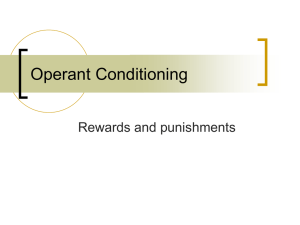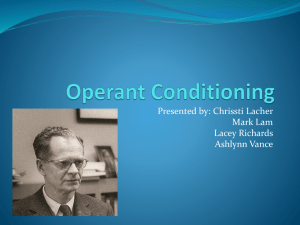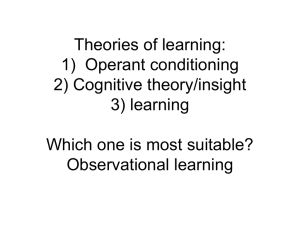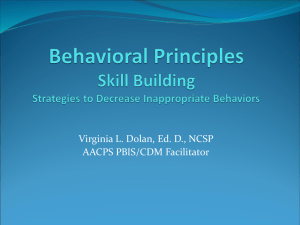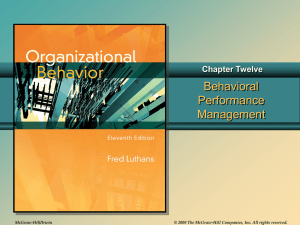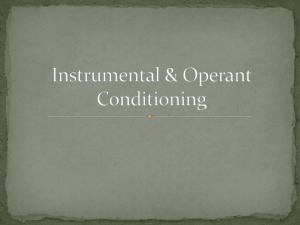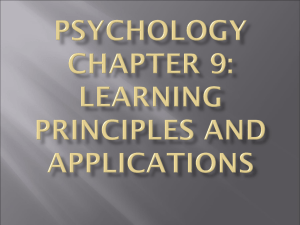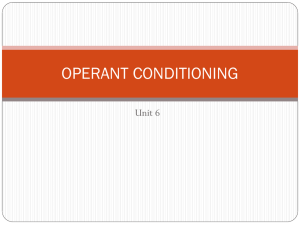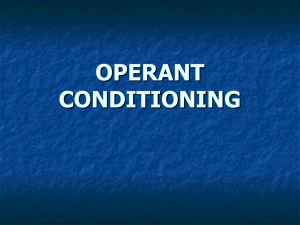File - Coach Wilkinson`s AP Euro Site
advertisement
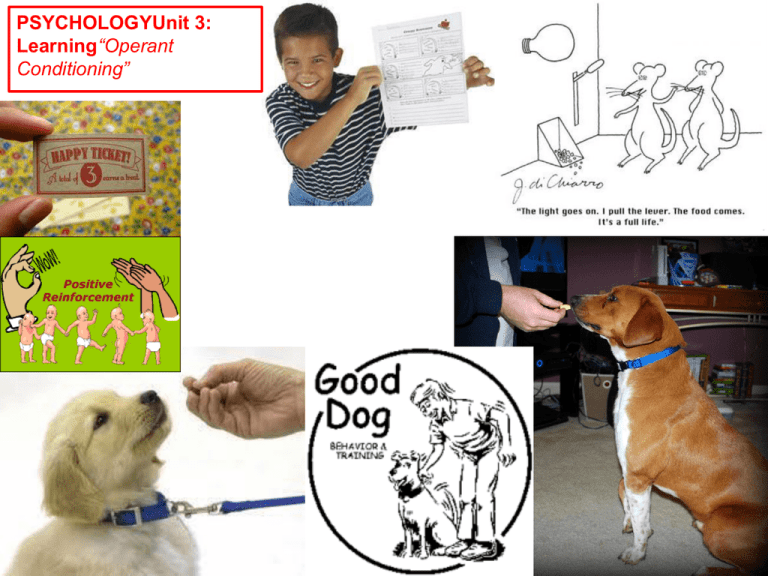
PSYCHOLOGYUnit 3: Learning“Operant Conditioning” What is Learning? Most learning is... Associative Learning: Realization that certain events occur together. Learning itself refers to a relatively durable change in behavior or knowledge that is due to experience. ★ Classical Conditioning ★ Operant Conditioning ★ Observational Learning (Latent, Abstract, Insight) Behaviorism Everything you know, everything you are is the result of human behavior. In other words, psychology is the study of behavior, not of the mind! Picked up steam in the late 1960s and during the 1970s. A reaction to the non-scientific work of Freud. B.F. Skinner Instead of antecedents of behavior (what comes before) a new focus on consequences of behavior. BF Skinner argued that, CC did not explain complex behavior. 2 categories of consequences: Reinforcement & Punishment Reinforcement is designed to increase the probability that a behavior will occur again. Punishment is designed to decrease the probability that a behavior will occur again. Operant Conditioning A type of learning in which behavior is strengthened if followed by reinforcement or diminished if followed by punishment in rats: ★ ★ ★ ★ trial and error learning allows acquisition of motor programs that are not instinctive behavior shaped by rewards develops as a result of the association of reinforcement with a particular response ★ on a proportion of occasions Trial & Error---------------->Trial & Reward---------->Operant Conditioning Operant Response - Reinforcement - Learned Behavior Positive reinforcement - when something is given (apply an aversive stimulus). Negative reinforcement - when something is removed (remove an aversive stimulus). Skinner - punishment should be judicious, immediate, consistent, & severe enough actually to be a punishment. http:// www.youtube.com/watch?v=guroaQRFsX4 Positive Reinforcement Strengthens a response by presenting a stimulus after a response. $$$ Getting Paid! We may continue to go to work each day because we receive a paycheck on a weekly or monthly basis. ***AWARDS*** If we receive awards for writing short stories, we may be more likely to increase the frequency of writing short stories. "PRAISE!" Receiving praise for our karaoke performances can increase how often we sing. Negative Reinforcement Strengthens a response by reducing or removing an aversive stimulus. Driving in heavy traffic is a negative condition for most of us. You leave home earlier than usual one morning, and don't run into heavy traffic. You leave home earlier again the next morning and again you avoid heavy traffic. Your behavior of leaving home earlier is strengthened by the consequence of the avoidance of heavy traffic. The concept of Negative Reinforcement is difficult to learn because of the word negative. Negative Reinforcement is often confused with Punishment. They are very different, however. Negative Reinforcement strengthens a behavior because a negative condition is stopped or avoided as a consequence of the behavior. Punishment Punishment, on the other hand, weakens a behavior because a negative condition is introduced or experienced as a consequence of the behavior. Punishment is often mistakenly confused with negative reinforcement. Remember, reinforcement always increases the chances that a behavior will occur and Punishment always decreases the chances that a behavior will occur. Punishment Positive Punishment: This type of punishment is also known as "punishment by application." Positive punishment involves presenting an aversive stimulus after a behavior as occurred. For example, when a student talks out of turn in the middle of class, the teacher might scold the child for interrupting her. Punishment Negative Punishment: This type of punishment is also known as "punishment by removal." Negative punishment involves taking away a desirable stimulus after a behavior as occurred. For example, when the student from the previous example talks out of turn again, the teacher promptly tells the child that he will have to miss recess because of his behavior. Punishment also has some notable drawbacks. First, any behavior changes that result from punishment are often temporary. "Punished behavior is likely to reappear after the punitive consequences are withdrawn," Skinner explained in his book About Behaviorism. Perhaps the greatest drawback is the fact that punishment does not actually offer any information about more appropriate or desired behaviors. While subjects might be learning to not perform certain actions, they are not really learning anything about what they should be doing. Another thing to consider about punishment is that it can have unintended and undesirable consequences. For example, while approximately 75 percent of parents in the United States report spanking their children on occasion, researchers have found that this type of physical punishment can lead to antisocial behavior, aggressiveness and delinquency among children. For this reason, Skinner and other psychologists suggest that any potential short-term gains from using punishment as a behavior modification tool need to be weighed again the potential long-term consequences. Punishment An event that DECREASES the behavior that it follows. Does punishment work? Tardies & D-HALLS The Breakfast Club was released in 1985. Saturday, March 24, 1984. Shermer High School, Shermer, Illinois. 60062. Dear Mr. Vernon, We accept the fact that we had to sacrifice a whole Saturday in detention for whatever it was that we did wrong… what we did was wrong, but we think you’re crazy to make us write this essay telling you who we think we are. What do you care? You see us as you want to see us… in the simplest terms & the most convenient definitions. You see us as a brain, an athlete, a basket case, a princess & a criminal. Correct? That’s the way we saw each other at seven o’clock this morning. We were brainwashed. http://www.youtube.com/watch?v=FpHWRzGSnUs http://www.youtube.com/watch?v=nMG Rck-fVJ0 A lot of students are confused about negative reinforcement. What's the difference between that and punishment? Remember, it's "reinforcement" so the behavior increases, and because it's "negative," the reinforcer is removed after the response. Positive or Negative Reinforcement? Cleaning the house to get rid of the disgusting mess and/or to stop your mother from nagging Positive or Negative Reinforcement? Cleaning the house to get rid of the disgusting mess and/or to stop your mother from nagging NEGATIVE REINFORCEMENT Strengthens a response by reducing or removing an aversive stimulus. Nagging/Mess as negative reinforcer to cleaning. Positive or Negative Reinforcement? Taking aspirin to relieve a headache Positive or Negative Reinforcement? Taking aspirin to relieve a headache NEGATIVE REINFORCEMENT Strengthens a response by reducing or removing an aversive stimulus. headache as negative reinforcer to taking medication. Positive or Negative Reinforcement? Listening to your favorite music after studying for an hour Positive or Negative Reinforcement? Listening to your favorite music after studying for an hour POSITIVE REINFORCEMENT: Strengthens a response by presenting a stimulus after a response. Positive or Negative Reinforcement? Leaving the movie theater if the movie is bad Positive or Negative Reinforcement? -- Leaving the movie theater if the movie is bad Negative Reinforcement strengthens a behavior because a negative condition is stopped or avoided as a consequence of the behavior. Positive or Negative Reinforcement? Giving in to an argument or to a child or dog’s begging Positive or Negative Reinforcement? Giving in to an argument or to a child or dog’s begging Negative Reinforcement strengthens a behavior because a negative condition is stopped or avoided as a consequence of the behavior. Negative reinforcement is NOT the same as punishment! Negative reinforcers, like all reinforcers, increase the frequency of the responses that they follow. (Punishment, in contrast, decreases the frequency of responses.) http://www.youtube.com/watch?v=i0ad 2NSwGb0 Fixed-ratio Schedules A schedule that reinforces a response only after a specified number of responses. Examples in natural environments: Jobs that pay based on units delivered. Employees often find this schedule undesirable because it produces a rate of response that leaves them nervous and exhausted at the end of the day. They may feel pressured not to slow down or take rest breaks, since they feel that such will costs them money. This is an example of how a schedule can produce a high rate of response even though the response rate is aversive to the subject. Examples in video games: Collecting tokens. Many games require the player to collect a fixed number of tokens to advance to the next level, obtain a new life point, or receive some other reinforcers. Attaining a new level in an RPG. Some RPG's clearly indicate how much experience is required to achieve the next level. A high degree of certainty as to the level of work that Variable-ratio Schedule A schedule of reinforcement that reinforces a response after an unpredictable number of responses. Slot machines: Slot machines are programmed on VR schedule. The gambler has no way of predicting how many times he must put a coin in the slot and pull the lever to hit a payoff but the more times a coin is inserted the greater the chance of a payout. People who play slot machines are often reluctant to leave them, especially when they have had a large number of unreinforced responses. They are concerned that someone else will win the moment they leave. Playing golf: It only takes a few good shots to encourage the player to keep playing or play again. The player is uncertain how good each shot will be, but the more often they play, the more likely they are to get a good shot. Door to door salesmen: It is uncertain how many houses they will have to visit to make a sale, but the more houses they try, the more likely that they will succeed. Fixed-interval Schedule A schedule of reinforcement that reinforces a response only after a specified time has elapsed. An example might be getting a raise every year and not in between. A major issue with this schedule is that people tend to improve their performance right before the time period expires so as to "look good" when the review comes around. Example: I give Bart a Butterfinger every ten minutes after he moons someone. "HAHA!" In the Real World: A weekly paycheck is a good example of a fixed-interval schedule. The employee receives reinforcement every seven days, which may result in a higher response rate as payday approaches. Variable-interval Schedule A schedule of reinforcement that reinforces a response at unpredictable time intervals. Reinforcing someone after a variable amount of time is the final schedule. If you have a boss who checks your work periodically, you understand the power of this schedule. Because you don’t know when the next ‘check-up’ might come, you have to be working hard at all times in order to be ready. In this sense, the variable schedules are more powerful and result in more consistent behaviors. This may not be as true for punishment since consistency in the application is so important, but for all other types of reinforcement they tend to result in stronger responses. http://www.youtube.com/watch?v=7k47 hLVBYuY Shaping A procedure in Operant Conditioning reinforces & guides behavior closer and closer towards a goal. Reinforcers guide behavior, step-by-step. Closer and closer to the target behavior through successive approximations. “Baby Steps” Reinforcers Any event that STRENGTHENS the behavior it follows. There are + and – reinforcers. + Positive Reinforcers: Strengthens a response by presenting a stimulus after a response. - Negative Reinforcers: Strengthens a http://www.youtube.com/watch?v=OCU WHP4YDgU http://www.youtube.com/watch?v=ncFCdCjBqcE Classical vs. Operant They both use acquisition, discrimination, SR, generalization and extinction. Classical Conditioning: automatic (respondent behavior). Ex.) Your dog gets sick and requires several painful trips to the vet. Now he hides every time he hears you rattle your keys. Automatic. Operant Conditioning: behavior where one can influence their environment with behaviors which have consequences (operant behavior). Ex.) Teacher comments on test.
